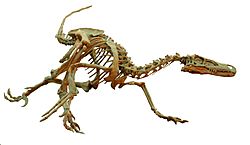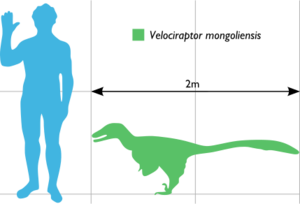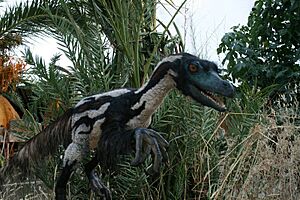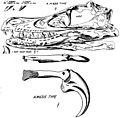Velociraptor facts for kids
Quick facts for kids VelociraptorTemporal range: Upper Cretaceous
|
|
|---|---|
 |
|
| Velociraptor. | |
| Scientific classification | |
| Kingdom: | |
| Class: | |
| Superorder: | |
| Order: | |
| Suborder: | |
| (unranked): | |
| Family: | |
| Genus: |
Velociraptor
|
Velociraptor was a small, fast dinosaur that lived about 75 to 71 million years ago. It was a type of theropod, which means "beast foot," and belonged to a group called dromaeosaurs. Velociraptor was a smaller cousin of the more famous Deinonychus. Its fossils were first discovered in the Gobi Desert of Mongolia in 1922.
Contents
Description
Velociraptor had a special sickle-shaped claw on each foot. This claw was about 6.5 centimeters (2.5 inches) long. It also had smaller claws on its hands. Velociraptor was warm-blooded and had feathers.
This dinosaur was slender and lightly built. It was a carnivore, meaning it ate meat. Velociraptor was about two meters (nearly seven feet) long. It stood about 0.62 meters (two feet) tall at its hip. This makes it bigger than a common chimpanzee.
The skull of Velociraptor was quite long. It could grow up to 23 centimeters (9 inches) in length. Its teeth were similar in shape and had small serrations, like tiny saw teeth. These serrations were sharper on the back edge of each tooth.
Diet
Velociraptor was a skilled meat-eater. It actively hunted smaller animals. It used its speed, quickness, sharp senses, and special claws and teeth to catch and kill its prey. It also likely ate animals it found already dead, which is called scavenging. Its diet probably included many different animals that lived in its environment. For example, it might have hunted the plant-eating Protoceratops and possibly even flying pterosaurs.
History of discovery
The first Velociraptor fossil was found on August 11, 1923. It was discovered by Peter Kaisen during an American Museum of Natural History trip. This happened at the Flaming Cliffs in the Gobi Desert, Mongolia. The fossil was a crushed but complete skull, along with one of its special toe claws.
In 1924, the museum president, Henry Fairfield Osborn, named this new dinosaur Velociraptor. The name comes from Latin words: velox means 'swift' and raptor means 'robber' or 'plunderer'. This name describes the dinosaur's speed and its meat-eating diet.
For many years, American teams could not go to Mongolia. But scientists from the Soviet Union and Poland, working with Mongolian experts, found more Velociraptor fossils.
Later, between 1988 and 1990, a team from China and Canada found Velociraptor remains in northern China. American scientists returned to Mongolia in 1990. A joint Mongolian-American team found several well-preserved skeletons in the Gobi Desert.
In 1999, scientists Rinchen Barsbold and Halszka Osmólska reported finding a young Velociraptor skeleton. It was a complete skeleton, including the skull of a young dinosaur.
Feathers
In September 2007, researchers found small bumps on the forearm of a Velociraptor fossil from Mongolia. These bumps are called quill knobs. In birds, these knobs show where feathers attach to the bone. Finding them on Velociraptor means it also had feathers.
Scientists believe that the feathers on Velociraptor and its relatives had different uses. They were likely not for flying, as Velociraptor was too heavy. Instead, the feathers might have been used for display, like showing off to other dinosaurs. They might also have been used to cover their nests while brooding their eggs, keeping them warm.
Most scientists think that dinosaur feathers first helped with keeping warm. Other uses, like display, came later.
Senses
Velociraptor had excellent hearing. It could hear a wide range of sounds. This helped it track prey easily. It was a quick and agile hunter. It might have eaten dead animals if food was scarce, or if it was sick or old.
Metabolism
Velociraptor was warm-blooded to some extent. It needed a lot of energy to hunt. Modern animals with feathers or fur, like Velociraptor had, are usually warm-blooded. This is because these coverings help keep their body temperature stable.
Species
Scientists have found fossils from two types of Velociraptor:
- V. mongoliensis found in Mongolia
- V. osmolskae found in Inner Mongolia, China
In both places, the environment was dry when these dinosaurs lived. There were sand dunes and sometimes small streams.
Media
Movies like Jurassic Park and some of The Land Before Time films made Velociraptor very famous. However, the raptors in Jurassic Park were much larger than real Velociraptors. They were actually the size of Deinonychus, a bigger relative. The movies also made them seem smarter than they probably were.
Relevant pages
Images for kids
-
The type skull of V. mongoliensis on display at the American Museum of Natural History
-
Mounted V. mongoliensis cast at Wyoming Dinosaur Center
-
V. mongoliensis restraining an oviraptorosaur with its sickle claws
See also
 In Spanish: Velociraptor para niños
In Spanish: Velociraptor para niños




















